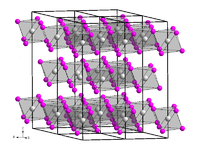Curium(III) iodide is the chemical compound with the formula CmI3.[1][2][3] Since all isotopes of curium are only artificially produced, the compound has no natural occurrence.

| |
| Names | |
|---|---|
| Other names
Curium triiodide
| |
| Identifiers | |
3D model (JSmol)
|
|
PubChem CID
|
|
| |
| |
| Properties | |
| CmI3 | |
| Molar mass | 628 g·mol−1 |
| Appearance | white crystals |
| Related compounds | |
Related compounds
|
Americium triiodide |
Except where otherwise noted, data are given for materials in their standard state (at 25 °C [77 °F], 100 kPa).
| |
Synthesis
editElemental curium and iodine can be reacted to synthesize curium(III) iodide.[4]
- 2Cm + 3I2 → 2CmI3
Also by the reaction of curium(III) chloride with ammonium iodide:[5][6]
- CmCl3 + 3NH4I → CmI3 + 3NH4Cl
Physical properties
editCurium(III) iodide is a colorless ionic compound consisting of Cm3+ and I− ions. It forms white crystals the hexagonal crystal system in the space group R3 (space group no. 148) with the lattice parameters a = 744 pm and c = 2040 pm with six units per unit cell. Its crystal structure is isotypic with that of bismuth(III) iodide.[5][7]
References
edit- ^ Lumetta, Gregg J.; Thompson, Major C.; Penneman, Robert A.; Eller, P. Gary (2006). "Curium". The Chemistry of the Actinide and Transactinide Elements. Springer Netherlands. pp. 1397–1443. doi:10.1007/1-4020-3598-5_9. ISBN 978-1-4020-3598-2. Retrieved 3 July 2023.
- ^ Brown, David; Canterford, J. H.; Colton, Ray (1968). Halides of the Transition Elements: Halides of the lanthanides and actinides, by D. Brown. Wiley. p. 260. ISBN 978-0-470-10840-6. Retrieved 3 July 2023.
- ^ "WebElements Periodic Table » Curium » curium triiodide". winter.group.shef.ac.uk. Retrieved 3 July 2023.
- ^ Seaborg, G. T.; James, R. A.; Ghiorso, A. (1949). "The Transuranium Elements". Science. 104 (2704). McGraw-Hill: 1554–1571. JSTOR 1675046. Retrieved 3 July 2023.
- ^ a b Asprey, L. B.; Keenan, T. K.; Kruse, F. H. (July 1965). "Crystal Structures of the Trifluorides, Trichlorides, Tribromides, and Triiodides of Americium and Curium" (PDF). Inorganic Chemistry. 4 (7): 985–986. doi:10.1021/ic50029a013. ISSN 0020-1669. S2CID 96551460. Retrieved 3 July 2023.
- ^ Koch, Günter (5 October 2013). Transurane: Teil C: Die Verbindungen (in German). Springer-Verlag. p. 154. ISBN 978-3-662-11547-3. Retrieved 3 July 2023.
- ^ Macintyre, Jane E. (23 July 1992). Dictionary of Inorganic Compounds. CRC Press. p. 3046. ISBN 978-0-412-30120-9. Retrieved 3 July 2023.